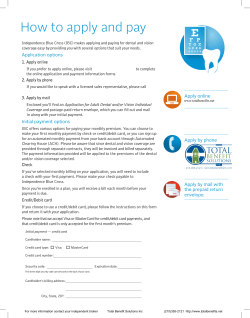
Rethinking payments how to
Cash management Rethinking how to manage international payments 34 Financial Services Research Q4 2011 Jesper Linden, Offering Manager, GTS Banks at SEB , talks to Bob Currie about how his team is helping financial institutions to redesign their international cash management arrangements The global financial crisis and recent turmoil in the eurozone have dictated that financial institutions and corporates continue to manage their international payments activity in an atmosphere of uncertainty. In this environment, treasurers are under pressure to optimise the efficiency of their liquidity management and to reinforce the risk management sitting around this process. In a volatile economic climate, issues of security and liquidity remain crucial. Are companies holding their cash somewhere safe? And can they access these cash balances promptly when required? Moreover, cash optimisation becomes particularly important. Some companies have accumulated significant piles of cash – and in the current low interest rate environment it is valuable to optimise yield on cash balances at acceptable levels of risk. Against this backdrop the need for a strong partner to support cash management activities and to manage the change agenda is essential. As Offering Manager for GTS Banks, Jesper Linden leads a team responsible for providing an integrated view on the transaction banking needs of the bank client segment (including custody, clearing and cash management). From a cash management perspective, this will involve providing integrated service delivery across clients’ full cash management needs: they are not interested in buying separately across different types of international payments or account structures. The client is wishing to buy a joined up service across each of these cash management products. Managing change With policy makers and financial authorities driving a constant stream of regulatory reform, cash managers are running hard to adapt to changing rules and refinements to the payments infrastructure. In helping clients to manage Cash management this change agenda, Jesper Linden highlights two development areas that sit at the heart of SEB’s cash management strategy for the banking segment. The first centres on cash clearing and liquidity provision, embracing SEB’s traditional inter-bank cash management business. The second is delivery of a white-label services product, enabling foreign banks to link to the local payments infrastructure via SEB as account operator, thereby operating in SEB’s home markets as if they are domestic banks. Though the traditional cash clearing service is a relatively mature product that SEB has offered for many years, the prevailing instabilities in global financial services dictate that banks are attaching huge importance to ensuring that their liquidity is managed in a secure and efficient environment. In facilitating this process, SEB is focused on improving cash visibility, cash mobility and in enhancing optimisation tools that are available to its client base. In managing these diverse client needs, SEB is working with transaction and cash management specialist Gresham C omputing. Financial institutions may have payment arrangements in place with 50 or 100 provider banks (and there may be multiples of account with each provider), many of which may employ slightly differing system capa- Cash mobility is fundamental in enabling SEB’s customers to discharge their payment obligations. Clients must verify that they have funds available in the right place and that they have control over which payments go out first. SEB offers advanced sweep functionality which allows funds to be allocated to where these are most needed. In a number of markets, it also has the ability to time stamp outbound payments such that they will be held on the account until these need to be paid. To maximise efficiency across this process, effective cash optimisation is important to ensure that any funds remaining in the account end of day can be swept into high-yielding accounts in line with the client’s preferred risk appetite. FSR asked Jesper Linden how the economic climate has shaped clients’ demand for cash optimisation in the face of this existing low interest rate environment. For example in the UK, FSA Client Asset rules stipulate that English banks may not hold more than a specified percentage (currently 20 per cent) of their clients’ cash deposits in their own books. The balance must be held in the books of other banking institutions. As a result, banks are setting in place deposit arrangements with multiple banking counterparts. “Given the strong credit rating of SEB as a bank and the fact that the Nordic markets ex Finland are comparatively well insulated from the euro, this has contributed to strong cash relationships between SEB and a number of UK-based banks,” explains Linden. “But, inevitably, client banks are seeking attractive yield on the cash balances involved. SEB has developed Financial Services Research Q4 2011 35 In the cash visibility area, banks are seeking close control of their counterparty exposures – including the ability to monitor open position exposures in real time, to mitigate key risks across these exposures and to meet the delivery commitments created by these payment obligations. To facilitate this process, SEB continues to enhance its reporting capability in line with the variegated needs of its clients. Some may wish to receive SWIFT-based reporting intraday, receiving MT942s that confirm transactions they have received during the past 30 or 60 minutes. Others may ask SEB to pre-advise them on outstanding payments and to inform them if any anticipated payments have not completed as expected. Many clients may wish to monitor cash balances and open positions via a Web-based portal. SEB provides flexibility to accommodate each of these client preferences. bilities and message formats even within the SWIFT standards. Gresham Computing has helped SEB to manage these operational complexities, standing as an interoperability hub. Clareti Cash Reporting (CCR) will take in messages in a diverse array of format, it will cleanse and standardise this message information such that it can be forwarded to the recipient in a standard message format such as ISO 20022 XML or presented in a consolidated manner through an online portal. As a result, SEB is able to deliver a consolidated real-time view of transactions across a client bank’s network of correspondent banking partners. Cash management a range of flexible interest rate models – offering a tiered interest rate based on the inter-bank base rate plus a margin for banks with sizeable cash balances on deposit – and interest-netting facilities.” White label services 36 Financial Services Research Q4 2011 In parallel with these commitments, SEB continues to invest in the development of its white labelled services – named ‘network-managed payment services’ or ‘re-account models’ by some banking institutions. “Traditionally when banks have wanted to support the international payments activity of customers in markets in which they do not have a presence, typically they have referred this business on to a cash correspondent partner with specialist expertise in the local market,” says Linden. “But for a number of banks’ key clients, such referral arrangements may no longer suffice. Their global payments needs require the same level of operational efficiency and cost efficiency as their domestic payments and they are reviewing their international payments arrangements to move them closer to this goal.” In supporting this demand, SEB has been working closely with a number of global banking institutions as they review the structure of their international payments networks. In some locations, these clients may have their own bank branches and will meet clients’ payments needs through their own cash clearing capability. But in other locations this approach may not be practical. In the Nordic markets, a number of financial institutions now employ SEB’s payments architecture on a white-labelled basis to service their Nordic payments activity, providing access to the domestic cash clearing infrastructure and extending local currency accounts to international clients as if they are using a domestic bank. For instance, HSBC has announced a partnership arrangement with SEB through which SEB will provide access to local payments clearing systems on HSBC’s behalf. Through this arrangement, the HSBC customer will (for example) have an SEK account in London that will be directly connected to the Swedish infrastructure to support domestic cash payments. However, it will be supported by HSBC relationship manage- ment staff and it will manage its payments activity via the same client interface and delivery model employed by HSBC in other markets worldwide. This partnership arrangement offers the additional benefit that it will accelerate procedures for account opening, potentially shortening the time taken for completing new account agreements in the Nordic markets from several weeks down to 2-3 days. SEB established its first client under these arrangements approximately 10 years ago. “For a number of years we saw limited activity for this product, but during the past 2-3 years a number of banks have made a strategic choice to restructure their international cash management arrangements,” says Linden. “It is challenging for a US or an Asia-Pacific based bank to know how to support efficient cash management services across the Nordic markets – it takes time to build this expertise and to establish an efficient cash management infrastructure.” Recently, SEB launched its Multi-currency Direct Debit Service, enabling SEB’s financial institution clients to access direct debit schemes in the Danish, Norwegian and Swedish markets. As a Nordic cash management specialist, SEB is able to insulate the client from the complexity of managing each DD scheme individually. “For clients using the SEPA direct debit payments system, for instance, we can take in instructions in ISO 20022 XML format and convert this into the proprietary formats employed by each of the three Scandinavian payments clearing houses, thus enabling these customers to re-use the developments that they have done to process SEPA direct debits,” says Linden. Financial institutions are seeking an alternative to fragmented local correspondent banking relationships and many are attempting to establish a smaller number of centralised regional solutions to meet the cross-border payment requirements of their customers. SEB has established a sophisticated white-label offering for the Nordic markets and is well placed to fulfil the needs of international customers seeking to meet their global coverage through this type of regionalised payments and cash management solution.
© Copyright 2025












